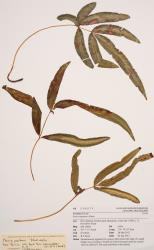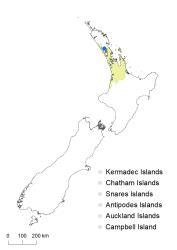- = Pteris lomarioides Colenso, Trans. & Proc. New Zealand Inst. 13: 380 (1881)
- = Pteris nipponica W.C.Shieh, Bot. Mag. (Tokyo) 79: 285 (1966)
In New Zealand, Pteris parkeri is known with certainty only from one collection with three sterile fronds. Rhizome unknown. Fronds 250–340 mm long. Stipes yellow-brown, 110–180 mm long; rachises not winged. Laminae 1‑pinnate to 2-pinnate at base, ovate, 140–190 mm long, 110–130 mm wide; primary pinnae in 2 pairs below a long terminal segment, the longest 75–115 mm long, 12–18 mm wide, bicolorous with the central portion yellow-green, apices acute, margins slightly serrate, bases sessile or short-stalked; basal pair of primary pinnae divided to the midrib into a single secondary pinna on the basiscopic side. Veins free. Sori unknown.
North Island: Auckland
Altitudinal range: c. 60 m.
Recorded only near Matakohe, northern Kaipara Harbour.
Occurs naturally in China, Korea, Japan and Taiwan, and is naturalised in Nepal and North America.
Recorded as occurring spontaneously in a grassy ditch beside a road.
Possibly first recorded by Colenso (1881) as P. lomarioides. Voucher AK 135538. First confirmed record Parris (2018). Voucher AK 330571, 2012.
The voucher collection of this plant was initially identified by Parris as Pteris nipponica W.C.Shieh, but she subsequently noted that Fraser-Jenkins (2008) had pointed out that the correct name is actually Pteris parkeri. Parris (2018) created the new combination Pteris parkeri var. albolineata (Hook.) Parris for a variegated form first described as P. cretica var. albolineata by Hooker (1860) from a plant cultivated at Buitenzorg Botanical Garden, Java. The New Zealand collection matches this variety. Parris noted that epithets published in conformity with the Code may be used as cultivar epithets, and since the variety was described from a cultivated plant, it can be known as Pteris parkeri ‘Albolineata’. She also stated that the plant had been in the horticultural trade in New Zealand for at least 30 years.
A juvenile frond, which was described by Colenso (1881) as P. lomarioides, may be a much earlier record of P. parkeri in New Zealand, but its identity requires confirmation. It lacks the variegation of Parris’s more recent collection, and would not be identified in the key to species of Pteris provided here. It was included in the synonymy of P. cretica by Cheeseman (1906).





